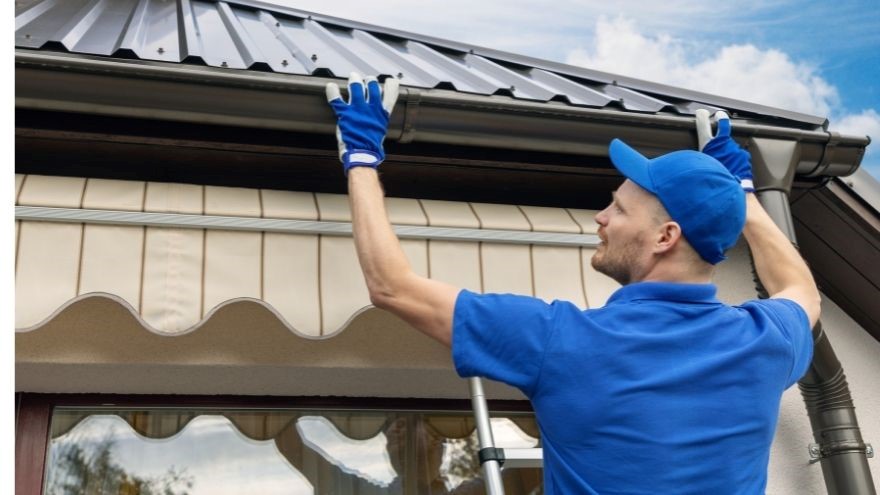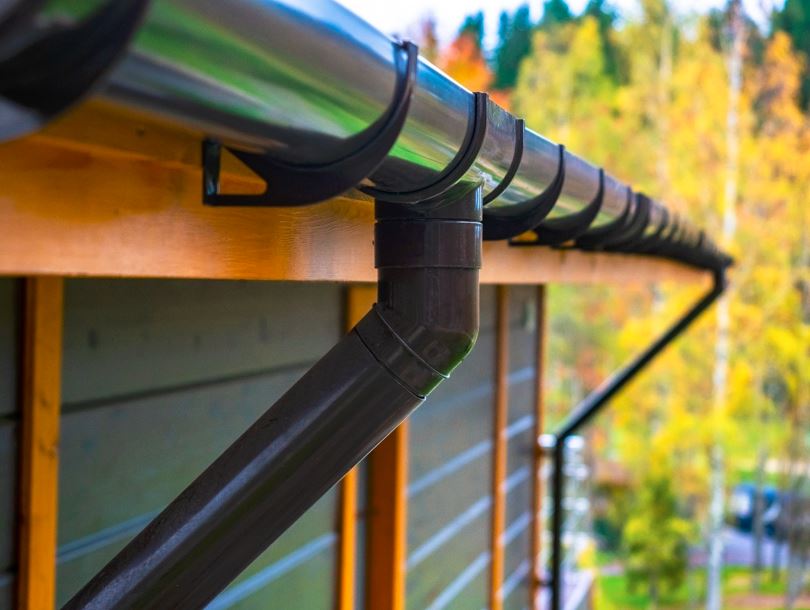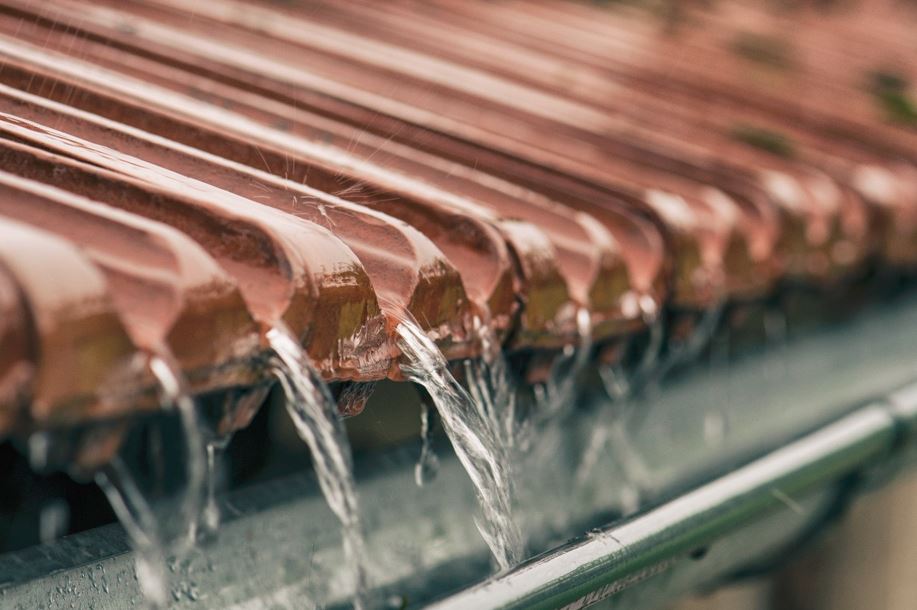The main task of the gutter system is to drain rainwater away from the building. The appropriate selection of individual installation elements therefore affects the level of safety and comfort of the facility's users. This responsibility usually falls on the roofing contractor because the gutters are purchased and installed together with the roofing. Each installer should therefore consider what factors to take into account in the decision-making process.

From this article you will learn:
- what does the gutter system consist of,
- what types of gutters are available on the market,
- what to consider when selecting gutters,
- how to drain and store rainwater.
What elements does a gutter system consist of?
For the average user, a gutter system is simply a few pipes running along the edges of the roof and walls of a building. However, an experienced installer knows that it is a complex structure that includes many elements with various functions. Their selection and adjustment determines the functionality and safety of the entire system. So what does the installation include?
- Gutter ducts - characterized by an open cross-section and running along the edge of the roof. They constitute one of the two key elements of the entire system. Their function is to collect water from the roof surface. They are installed with a slight slope towards the corners of the building, which allows rainwater to flow freely into the downpipes. In addition to classic round gutters, some manufacturers also offer rectangular or elliptical ducts, as well as variants with a deeper profile intended for the most demanding customers.
- Drain pipes - the second key element of the system, which is mounted vertically on the walls of the facility. Rusy are characterized by a closed cross-section and a shape adapted to the gutters. Their task is to direct water flowing from the roof outside the building.
- Drains - fittings used to connect gutters with downpipes. There are through and end drains on the market.
- Corners - these are elements necessary to connect gutters in the corners of the building - both external and internal.
- Spouts - as the name suggests, these shapes direct rainwater into the sewage system or into the ground.
- Clamps - universal accessories used for installing downpipes on building walls.
- Hooks - structural elements that are primarily intended to support gutters. They provide permanent attachment to rafters or battens.
- Gutters - additional gutter mounting accessories that adapt to the shape of the roof and the planned slope of the cables.
- Connectors - various types of elements used to connect both gutters and downpipes. In the latter case, they can take the form of elbows, tees, reductions or joints.
Check out Wavin products at the Onninen wholesaler
It is worth remembering that in addition to the above elements that you will find in every gutter system, there are also additional parts available on the market. They are used only in certain cases - to complement or finish the installation. This includes, among others:
- Chains - sometimes replacing downspouts.
- Gargoyles - which also replace drain pipes, and sometimes also have a decorative function (for example, they take the shape of gargoyles, etc.).
- Covers - i.e. elements that retain water in the gutters .
- Strainers - retaining impurities and ensuring patency of pipes.
- Inspections - allowing for easy inspection and cleaning of downpipes.
- Rainwater catchers - elements that allow rainwater to be drained into a special tank.
What types of gutters are there?
 Gutters available on the market differ mainly in the material from which they are made:
Gutters available on the market differ mainly in the material from which they are made:
- PVC - polyvinyl chloride gutters are the cheapest solution, but it is difficult to deny its functional character. Due to the fact that these cables can be available in countless colors, they can be easily matched to any roof covering. These types of gutters are resistant to corrosion, difficult weather conditions and various types of mechanical damage.
- Coated sheet metal - this is the choice that is considered the most resistant to mechanical damage. Although these gutters are made of galvanized steel, their external coatings are colored in a variety of colors, which makes it easier to match them to a specific project. The durability of this type of elements is estimated at 25 - 50 years, but deeper scratches may accelerate the corrosion process.
- Aluminum - gutters made of aluminum sheet have excellent anti-corrosion properties and their service life reaches 50 years. The metal can be varnished, painted or coated with a protective material, so cables of this type are also available in a wide range of colors.
- Copper is an expensive solution, even considered a luxury. The copper sheet is not covered with any other layer, so it retains its color, which over time becomes covered with a greenish patina. Although it has anti-corrosion properties, it can cause rusting of steel, aluminum or zinc-titanium sheets if it comes into contact with them.
In stores you will also find zinc-titanium gutters , which can, in a sense, be compared to copper gutters. They are available only in their natural graphite color, are characterized by a high level of durability and... are expensive.
As we mentioned earlier, gutters can also differ in shape and size. This last parameter should be strictly dependent on the roof surface.
Exchange benefits in the new OnnTop loyalty platform!
What should you consider when selecting gutters?
 The appropriate selection of individual elements of the gutter system guarantees its efficiency and the safety of users of a given building. To provide the facility with reliable gutters, the contractor responsible for the roof design should be guided primarily by the size of the covering. This is a key factor when choosing the diameter of the cables.
The appropriate selection of individual elements of the gutter system guarantees its efficiency and the safety of users of a given building. To provide the facility with reliable gutters, the contractor responsible for the roof design should be guided primarily by the size of the covering. This is a key factor when choosing the diameter of the cables.
Therefore, the purchase of gutters should be preceded by the calculation of the so-called Effective Roof Area. Knowing its value, you can match specific gutters to the project. Approximate estimates allow this principle to be reduced to the following allocations:
- roof with a small area (up to 50 m 2 ) - recommended gutters with a diameter of 100 mm and downpipes with a diameter of 75 - 80 mm,
- medium roof (50 - 100 m 2 ) - recommended gutters with a diameter of 125 mm and downpipes with a diameter of 90 mm,
- roof with a large area (over 100 m 2 ) - recommended gutters with a diameter of 150 or 190 mm and downpipes with a diameter of 110 - 120 mm.
When selecting roof gutters for a facility, you should, of course, also take into account the previously mentioned criteria, i.e. material and color. These are factors that should depend on, among others, weather conditions and the architectural style of the building.
Rainwater storage
It is worth making your customers aware of the fact that an effective gutter system can be used to drain and collect rainwater. Just complete the installation with a capacious rainwater tank . The rainwater collected in it is perfect for, among others:
- watering the lawn or plants in the garden,
- household chores, such as cleaning the driveway or washing the car,
- certain household activities, such as flushing the toilet.

Check out rainwater tanks at the Onninen wholesaler
When looking for reliable rainwater tanks, as well as individual elements of the gutter system for your clients, be sure to check out the assortments of the Roth , Wavin and Geberit brands, available in the offer of the Onninen installation wholesaler !
Do you have questions about the industry? Join the Świat Instalacji group!